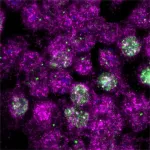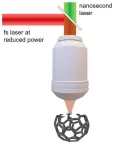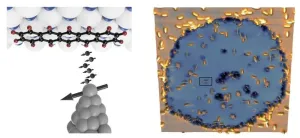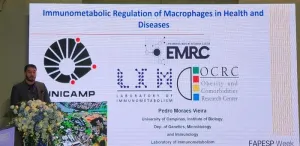(Press-News.org) How would you summarize your study for a lay audience?
We set out to identify genes that are commonly expressed in CD8+ T cells, killer immune cells that can drive anti-tumor immunity, across many types of human cancers. Our goal was to uncover new therapeutic targets, which could inform novel treatment strategies that could benefit many patients. To do this, we developed a novel mathematical method that can be applied to data from many types of cancers.
What knowledge gaps does your study help to fill?
We know the presence fof CD8+ T cells is essential for attacking and destroying cancer cells. If we can prolong the survival of these cells, then they can work longer to destroy cancer cells.
How did you conduct your study?
We created and implemented a novel mathematical method that can identify patterns in data and be applied to analyze diverse datasets across multiple human cancers to reveal shared or unique gene programs. We applied this formula to study 33,161 CD8+ T cells fro 132 patients with seven different types of cancer. We thus identified 72 genes that we commonly expressed in chronically activated CD8+ T cells across these cancers. We found that one of these genes, CXCR6, can support the survival of CD8+ T cells by promoting CD28 signaling.
What are the implications?
Because the mathematical method we developed can be applied to analyze diverse datasets across multiple human cancers to uncover shared or unique gene programs, we can identify common, as well as unique, targets for cancer therapeutics, Our findings can help inform targets for broadly active cancer therapies,
What are the next steps?
Using the same method, we will identify unique targets for specific cancer types and continue to test additional genes within our 72 "pan-cancer" candidates for therapeutic translation and application.
Authorship: In addition to Anderson, additional Brigham and Women's Hospital authors include Katherine Tooley, Giulia Escobar, S. Harsha Krovi, Davide Mangani, Gitanjali Dandekar, Hanning Cheng, Conner Lambden, Rajesh Krishnan
Funding: This work was supported by funds provided by the President's Scholar Award and grants from the National Institutes of Health (R01CA187975; P01CA236749) the Klarman Cell Observatory at the Broad Institute, and Howard Hughes Medical Institute.
Paper cited: Tooley, K et al. "Pan-cancer mapping of single CD8+ T cells profiles reveals a TCF1:CXCR6 axis regulating CD28 co-stimulation and anti-tumor immunity." Cell Reports Medicine DOI: https:doi.org/10.1016/j.xcrm.2024.101640
END
Research spotlight: Identifying genes to prolong an anti-tumor immune response
2024-07-02
ELSE PRESS RELEASES FROM THIS DATE:
SRI is developing a new malaria treatment that aims to protect from the disease
2024-07-02
SRI today announced that researchers are developing a new treatment that aims to provide a better option to fight malaria, particularly for people in low-income and rural regions. Researchers in SRI’s Pharmaceutical Sciences Lab are working on an affordable, shelf-stable anti-malarial drug formulation that could provide months of protection against the mosquito-borne disease with just a single injection, which means that individuals would no longer have to worry about missing a dose. Additionally, it has a low propensity for resistance and can be ...
UV radiation damage leads to ribosome roadblocks, causing early skin cell death
2024-07-02
In a recent study, researchers at Johns Hopkins Medicine suggest the cell’s messenger RNA (mRNA) — the major translator and regulator of genetic material — along with a critical protein called ZAK, spur the cell’s initial response to UV radiation damage and play a critical role in whether the cell lives or dies.
While UV radiation has long been known to damage DNA, it also damages mRNA, and the latest findings, published June 5 in Cell, indicate that mRNAs act as first responders in telling the cells how to manage the stress.
“RNA is a canary in the coal mine. It’s telling the cell, ‘We’ve got major damage here and ...
Precise and less expensive 3D printing of complex, high-resolution structures
2024-07-02
WASHINGTON — Researchers have developed a new two-photon polymerization technique that uses two lasers to 3D print complex high-resolution structures. The advance could make this 3D printing process less expensive, helping it find wider use in a variety of applications.
Two-photon polymerization is an advanced additive manufacturing technique that traditionally uses femtosecond lasers to polymerize materials in a precise, 3D manner. Although this process works well for making high-resolution microstructures, it isn’t widely used in manufacturing ...
AGS member, George Kuchel, appointed to serve on ACIP
2024-07-02
The American Geriatrics Society extends its warmest congratulations to ADGAP President George Kuchel, MD, CM, FRCP on his appointment as a member expert of the Advisory Committee on Immunization Practices (ACIP). ACIP develops recommendations on the safe use of vaccines in the United States.
Dr. Kuchel, who became President of the Association of Directors of Geriatrics Academic Programs in spring 2024, is Director of both the UConn Center on Aging and the Claude D Pepper Older Americans Independence Center at the University of Connecticut. He has significant expertise and knowledge in vaccines and immunology, particularly in older adults, including performing ...
Researchers awarded Department of Defense grant to study the role of gut microbiomes to improve outcomes in dystonia
2024-07-02
Mohammad Moshahid Khan, PhD, principal investigator and associate professor in the Department of Neurology in the College of Medicine at the University of Tennessee Health Science Center, was recently awarded a $308,000 grant from the Department of Defense for a study that will investigate the role of the gut microbiome in dystonia, a movement disorder of abnormal postures and involuntary twisting or repetitive movements, to improve neurobehavioral outcomes. Jianfeng Xiao, MD, PhD, associate professor in the Department of Neurology, is the co-investigator of the study.
Although ...
Advancing toward a preventative HIV vaccine
2024-07-02
LA JOLLA, CA and NEW YORK, NY—A major challenge in developing a vaccine for HIV is that the virus mutates fast—very fast. Although a person initially becomes infected with one or a few HIV strains, the virus replicates and mutates quickly, resulting in a “swarm” of viral strains existing in a single body. But scientists at Scripps Research; IAVI; the Ragon Institute of Mass General, MIT, and Harvard; La Jolla Institute for Immunology; and additional institutions have conducted a series of preclinical ...
A Global Heat Early Warning system is now essential, and requires planning in four key areas to overcome barriers and enable successful implementation, per new review
2024-07-02
A Global Heat Early Warning system is now essential, and requires planning in four key areas to overcome barriers and enable successful implementation, per new review.
####
Article URL: https://journals.plos.org/climate/article?id=10.1371/journal.pclm.0000437
Article Title: Preventing heat-related deaths: The urgent need for a global early warning system for heat
Author Countries: Austria, Denmark, Sweden, Switzerland, US
Funding: CB,IMO, CG and JT are funded by Horizon Europe through the HIGH horizon project funded by the European Union’s Horizon Europe Programme (grant number 101057843). IMO and CG are also ...
An alternative way to manipulate quantum states
2024-07-02
Electrons have an intrinsic angular momentum, the so-called spin, which means that they can align themselves along a magnetic field, much like a compass needle. In addition to the electric charge of electrons, which determines their behaviour in electronic circuits, their spin is increasingly used for storing and processing data. Already now, one can buy MRAM memory elements (magnetic random access memories), in which information is stored in very small but still classical magnets – that is, ...
Study reveals new factor associated with the risk of severe COVID-19 in people with obesity
2024-07-02
Already at the beginning of the COVID-19 pandemic, a group of Brazilian researchers pioneered in showing why SARS-CoV-2 infection tends to be more severe in diabetic patients. Now, the same team based at the Institute of Biology of the State University of Campinas (IB-UNICAMP) has discovered one of the reasons why obese people who do not have diabetes or even insulin resistance also have an increased risk of developing the severe form of the disease.
“New experiments show that the molecular mechanisms are quite different in the two cases,” Pedro Moraes-Vieira, a professor at IB-UNICAMP, who is coordinating ...
Study finds that influential people can play a valuable role in getting people to act in the best interest of society
2024-07-02
Getting individuals to act in the best interest of society can be a tricky balancing act, one that often walks a fine line between trying to convince people to act of their own volition, versus passing laws and regulations that make these actions compulsory.
In a new paper, published in the journal PNAS Nexus, SFI External Professor Stefani Crabtree (Utah State University) and Science Board Fellow Simon Levin (Princeton University), together with Colin Wren (University of Colorado, Colorado Springs) and Avinash ...





